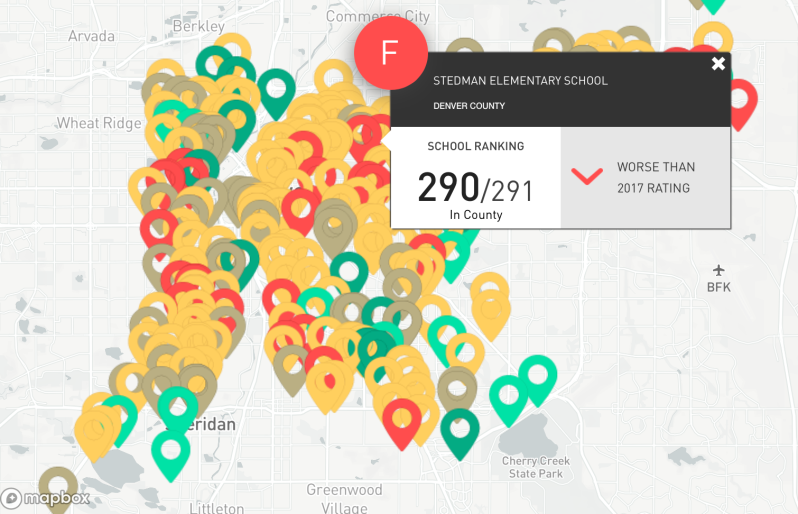The Denver Schools with the Worst Report Cards for Driving Behavior

The return of the school year can be a chaotic time for parents and students. That chaos apparently extends to terrible driving around Denver’s 290 schools.
Zendrive, a company that uses cellphone data to track driving behavior, studied how motorists drove around nearly 126,000 schools nationwide in April, including in Denver. By tracking the sensors in more than 9 million anonymous cellphones, Zendrive was able to catalog “risky behaviors” like cell phone use, speeding, and sudden braking or fast acceleration within a quarter-mile of schools.
The vast majority of city school received really bad grades — mostly D’s with plenty of F’s mixed in. Dangerous driving near schools earned the City and County of Denver an F overall, good for second-worst in the state, behind only Arapahoe County.
Thomas Jefferson High School in southeast Denver, where students already face a particularly hostile walking environment, received the city’s worst grade for careless driving. Four elementary schools rounded out the bottom five: Stedman, Green Valley, Barrett, and Cheltenham. (Check Zendrive’s website to look up your school’s stats.)
The data rings true for David Chen. He lives in Highland but drops his six-year-old off at school in Hilltop every morning — on a bike — and retrieves both of his kids via bicycle every afternoon. Their schools have crossing guards and orderly plans to manage traffic, he says, but that’s not always the case.
“We passed another school zone and I almost got run over by an SUV because she was merging into the drop-off zone for her school, and so she was kind of parked in the bike lane waiting to get into that drop zone,” Chen said. “So there are people who are absent minded, just focused on dropping off kids at school, that could run into you.”
Chen says the worst “hot spots” during his morning and afternoon routine are intersections with wide streets like Colorado Boulevard. Red-light runners abound. “I don’t know if they’re looking at their phones, but they go through the red light and end up in the middle of the intersection,” he said.
Driving and biking are a wash as far as commute times go, Chen says, and though he bikes more conservatively with his kids, the daily danger hasn’t deterred him from exercising his — and his children’s — right to the road.
“It’s more of a bonding experience, having them on the bike, versus isolated in the back seat in a car seat,” Chen said. “Having them up front allows us to talk to them, interact with the environment with them, so it’s not just the street whizzing by, and I find a lot of value in that.”
At a fifth of schools nationwide, drivers engaged in an average of two risky behaviors per trip, the study found. The hour between 3 and 4 p.m. was the riskiest time for students, when drivers were near the peak of bad behavior. That stat tracks with U.S. Department of Transportation data that says the deadliest time for students is just after the last school bell rings.


